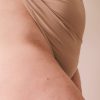
Abdominoplasty
Tummy Tuck (Full)
- Recovery time
- Approximately 2 to 4 weeks for everyday activities and 6 to 8 weeks before engaging in moderate physical activity.
- Anesthesia
- General
- Hospitalization
- 1 night under nurse supervision in our private hospital
Achieving a flat, firm abdomen
The full tummy tuck (abdominoplasty) addresses significant skin and muscle laxity of the abdomen. It removes excess skin and fat while tightening abdominal muscles. Unlike the mini tummy tuck, it treats the entire abdominal wall and involves repositioning the belly button.
Significant excess skin and fat (upper and lower abdomen).
Severe abdominal muscle separation (diastasis) after pregnancy
Post-weight-loss changes (including after Ozempic® / Wegovy®).
Stretch marks and advanced skin sagging.
Women seeking a full abdominal correction
Low horizontal incision from hip to hip (hidden in the bikini line).
Skin flap elevation up to the rib cage.
Repair of diastasis recti if necessary.
Removal of excess skin and fat.
Repositioning of the belly button.
General anesthesia.
2–3 hours.
Hopitalization (1 night).
Abdominal binder worn for 6 weeks.
Slightly bent posture initially, standing upright progressively.
Return to work in 2–3 weeks depending on activity.
Sports after 8 weeks.
Flatter, firmer abdomen.
Slimmer waistline, reshaped silhouette.
Long-lasting results with stable weight and healthy lifestyle.
Foire aux questions
The full version addresses the entire abdominal wall, repositions the belly button, and repairs diastasis, unlike the mini.
The scar is low, horizontal, and hidden in the bikini line. It fades over time.
Discomfort mainly comes from muscle tightening, but is well managed with pain relief.
Yes, liposuction is often added to refine the waist and optimize results.
Body surgical procedures for women
- Arm LiftBrachioplasty
- Thigh LiftCruroplasty
- Lipedema Treatment
- Rib Remodeling (RIBXCAR – “Barbie Waist”)
- Mini Tummy TuckMini-abdominoplasty
- Skin Thightening (Quantum RF / Morpheus8)
- NewHigh-Definition Liposuction (HD Lipo) - Total Definer Technique
- Supermodel Liposuction
- VASER® Liposuction
- Fat Transfer (U-Graft) / Lipofilling
- Buttock Augmentation and Remodeling (Brazilian Butt Lift - BBL)
- Fat Transfer / UGRAFT Body ContouringAutologous fat transfer using the U-GRAFT technique
- Muscle Definition (UGRAFT Technique)Muscle definition using autologous fat transfer (U-GRAFT technique)




